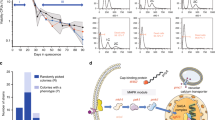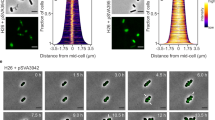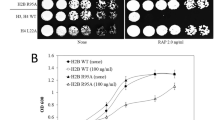Abstract
Synchronous cultures are often indispensable for studying meiosis. Here we present an optimized protocol for induction of synchronous meiosis in the fission yeast Schizosaccharomyces pombe. Chemical inactivation of an ATP analog–sensitive form of the Pat1 kinase (pat1-as2) by adding the ATP analog 1-NM-PP1 in G1-arrested cells allows the induction of synchronous meiosis at optimal temperature (25°C). Importantly, this protocol eliminates detrimental effects of elevated temperature (34°C), which is required to inactivate the commonly used temperature-sensitive Pat1 kinase mutant (pat1-114). The addition of the mat-Pc gene to a mat1-M strain further improves chromosome segregation and spore viability. Thus, our protocol offers highly synchronous meiosis at optimal temperature, with most characteristics similar to those of wild-type meiosis. The synchronization protocol can be completed in 5 d (not including strain production, which may take as long as 2 or 3 months).
This is a preview of subscription content, access via your institution
Access options
Subscribe to this journal
Receive 12 print issues and online access
$259.00 per year
only $21.58 per issue
Buy this article
- Purchase on Springer Link
- Instant access to full article PDF
Prices may be subject to local taxes which are calculated during checkout



Similar content being viewed by others
References
Kerr, G.W., Sarkar, S. & Arumugam, P. How to halve ploidy: lessons from budding yeast meiosis. Cell Mol. Life Sci. 69, 3037–3051 (2012).
Petronczki, M., Siomos, M.F. & Nasmyth, K. Un ménage à quatre: the molecular biology of chromosome segregation in meiosis. Cell 112, 423–440 (2003).
Watanabe, Y. Geometry and force behind kinetochore orientation: lessons from meiosis. Nat. Rev. Mol. Cell Biol. 13, 370–382 (2012).
Phadnis, N., Hyppa, R.W. & Smith, G.R. New and old ways to control meiotic recombination. Trends Genet. 27, 411–421 (2011).
Gregan, J. et al. High-throughput knockout screen in fission yeast. Nat. Protoc. 1, 2457–2464 (2006).
Bahler, J., Schuchert, P., Grimm, C. & Kohli, J. Synchronized meiosis and recombination in fission yeast: observations with pat1-114 diploid cells. Curr. Genet. 19, 445–451 (1991).
Bauer, F., Matsuyama, A., Yoshida, M. & Hermand, D. Determining proteome-wide expression levels using reverse protein arrays in fission yeast. Nat. Protoc. 7, 1830–1835 (2012).
Ellermeier, C. et al. RNAi and heterochromatin repress centromeric meiotic recombination. Proc. Natl. Acad. Sci. USA 107, 8701–8705 (2010).
Wood, V. et al. The genome sequence of Schizosaccharomyces pombe. Nature 415, 871–880 (2002).
Harigaya, Y. & Yamamoto, M. Molecular mechanisms underlying the mitosis-meiosis decision. Chromosome Res. 15, 523–537 (2007).
Nurse, P. Mutants of the fission yeast Schizosaccharomyces pombe which alter the shift between cell proliferation and sporulation. Mol. Gen. Genet. 198, 497–502 (1985).
Beach, D., Rodgers, L. & Gould, J. ran1+ controls the transition from mitotic division to meiosis in fission yeast. Curr. Genet. 10, 297–311 (1985).
Iino, Y. & Yamamoto, M. Mutants of Schizosaccharomyces pombe which sporulate in the haploid state. Mol. Gen. Genet. 198, 416–421 (1985).
Iino, Y. & Yamamoto, M. Negative control for the initiation of meiosis in Schizosaccharomyces pombe. Proc. Natl. Acad. Sci. USA 82, 2447–2451 (1985).
Watanabe, Y. & Yamamoto, M. S. pombe mei2+ encodes an RNA-binding protein essential for premeiotic DNA synthesis and meiosis I, which cooperates with a novel RNA species meiRNA. Cell 78, 487–498 (1994).
Watanabe, Y., Shinozaki-Yabana, S., Chikashige, Y., Hiraoka, Y. & Yamamoto, M. Phosphorylation of RNA-binding protein controls cell cycle switch from mitotic to meiotic in fission yeast. Nature 386, 187–190 (1997).
Yamamoto, A. & Hiraoka, Y. Monopolar spindle attachment of sister chromatids is ensured by two distinct mechanisms at the first meiotic division in fission yeast. EMBO J. 22, 2284–2296 (2003).
Guerra-Moreno, A., Alves-Rodrigues, I., Hidalgo, E. & Ayte, J. Chemical genetic induction of meiosis in Schizosaccharomyces pombe. Cell Cycle 11, 1621–1625 (2012).
Kakui, Y., Sato, M., Tanaka, K. & Yamamoto, M. A novel fission yeast mei4 mutant that allows efficient synchronization of telomere dispersal and the first meiotic division. Yeast 28, 467–479 (2011).
Cipak, L., Hyppa, R.W., Smith, G.R. & Gregan, J. ATP analog-sensitive Pat1 protein kinase for synchronous fission yeast meiosis at physiological temperature. Cell Cycle 11, 1626–1633 (2012).
Gregan, J. et al. Construction of conditional analog-sensitive kinase alleles in the fission yeast Schizosaccharomyces pombe. Nat. Protoc. 2, 2996–3000 (2007).
Hyppa, R.W., Fowler, K.R., Cipak, L., Gregan, J. & Smith, G.R. DNA intermediates of meiotic recombination in synchronous S. pombe at optimal temperature. Nucl. Acids Res. 10.1093/nar/gkt861 (2013).
Tachibana-Konwalski, K. Pat(ting) boosts meiosis. Cell Cycle 11, 1876–1877 (2012).
Nosek, J. & Tomaska, L. A new tool for an old problem: synchronizing fission yeast cells during meiosis using an ATP analog-sensitive protein kinase. Cell Cycle 11, 1755–1756 (2012).
Perez-Hidalgo, L. & Moreno, S. Chemical inactivation of Pat1: a novel approach to synchronize meiosis. Cell Cycle 11, 1875 (2012).
Murakami, H. & Aiba, H. Another way to induce synchronous meiosis. Cell Cycle 11, 1874 (2012).
Wu, P.Y. Insights from a new tool for meiotic induction in fission yeast. Cell Cycle 11, 2050 (2012).
Sipiczki, M. & Ferenczy, L. Protoplast fusion of Schizosaccharomyces pombe auxotrophic mutants of identical mating-type. Mol. Gen. Genet. 151, 77–81 (1977).
Egel, R. & Egel-Mitani, M. Premeiotic DNA synthesis in fission yeast. Exp. Cell Res. 88, 127–134 (1974).
Cromie, G.A. et al. A discrete class of intergenic DNA dictates meiotic DNA break hotspots in fission yeast. PLoS Genet. 3, e141 (2007).
Cromie, G.A. et al. Single Holliday junctions are intermediates of meiotic recombination. Cell 127, 1167–1178 (2006).
McLeod, M., Stein, M. & Beach, D. The product of the mei3+ gene, expressed under control of the mating-type locus, induces meiosis and sporulation in fission yeast. EMBO J. 6, 729–736 (1987).
Yamamoto, T.G., Chikashige, Y., Ozoe, F., Kawamukai, M. & Hiraoka, Y. Activation of the pheromone-responsive MAP kinase drives haploid cells to undergo ectopic meiosis with normal telomere clustering and sister chromatid segregation in fission yeast. J. Cell Sci. 117, 3875–3886 (2004).
Funaya, C. et al. Transient structure associated with the spindle pole body directs meiotic microtubule reorganization in S. pombe. Curr. Biol. 22, 562–574 (2012).
Grallert, A. et al. Centrosomal MPF triggers the mitotic and morphogenetic switches of fission yeast. Nat. Cell Biol. 15, 88–95 (2013).
Tay, Y.D., Patel, A., Kaemena, D.F. & Hagan, I.M. Mutation of a conserved residue enhances sensitivity of analogue sensitized kinases to generate a novel approach for mitotic studies in fission yeast. J. Cell Sci. 126 (Part 21): 5052–5061 (2013).
Kawashima, S.A., Takemoto, A., Nurse, P. & Kapoor, T.M. Analyzing fission yeast multidrug resistance mechanisms to develop a genetically tractable model system for chemical biology. Chem. Biol. 19, 893–901 (2012).
Iino, Y., Sugimoto, A. & Yamamoto, M. S. pombe pac1+, whose overexpression inhibits sexual development, encodes a ribonuclease III-like RNase. EMBO J. 10, 221–226 (1991).
Spirek, M. et al. S. pombe genome deletion project: an update. Cell Cycle 9, 2399–2402 (2010).
Imai, Y. & Yamamoto, M. The fission yeast mating pheromone P-factor: its molecular structure, gene structure, and ability to induce gene expression and G1 arrest in the mating partner. Genes Dev. 8, 328–338 (1994).
Sabatinos, S.A. & Forsburg, S.L. Measuring DNA content by flow cytometry in fission yeast. Methods Mol. Biol. 521, 449–461 (2009).
Lu, B.C. Dark dependence of meiosis at elevated temperatures in the basidiomycete Coprinus lagopus. J. Bacteriol. 111, 833–834 (1972).
Malik, C.P. Effect of variations in temperature on meiosis in Gagea reticulata schultes. Nature 187, 805–806 (1960).
Francis, K.E. et al. Pollen tetrad-based visual assay for meiotic recombination in Arabidopsis. Proc. Natl. Acad. Sci. USA 104, 3913–3918 (2007).
Loidl, J. Effects of elevated temperature on meiotic chromosome synapsis in Allium ursinum. Chromosoma 97, 449–458 (1989).
Shimanuki, M. et al. Two-step, extensive alterations in the transcriptome from G0 arrest to cell division in Schizosaccharomyces pombe. Genes Cells 12, 677–692 (2007).
Takeda, K. et al. Synergistic roles of the proteasome and autophagy for mitochondrial maintenance and chronological lifespan in fission yeast. Proc. Natl. Acad. Sci. USA 107, 3540–3545 (2010).
Acknowledgements
This work was supported by Austrian Science Fund grants P23609 and P21437 and by the Slovak Research and Development Agency under contract nos. APVV-0111-12 and APVV-0334-12. Part of this research was supported by the US National Institutes of Health grant no. GM032194 to G.R.S. L.C. was supported by the (European Community's) Seventh Framework Programme (FP7/2007–2013) under grant agreement no. PERG07-GA-2010-268167. J.G. was supported by the (European Community's) Seventh Framework Programme (FP7/2007–2013) under grant agreement no. PCIG11-GA-2012-322300. S.P. was supported by A European Molecular Biology Organization (EMBO) long-term fellowship. We thank J. Ayte, A. Yamamoto, C. Zhang, H. Murakami, A. Lorenz and Z. Benko for helpful discussions.
Author information
Authors and Affiliations
Contributions
J.G. and G.R.S. designed the experiments and wrote the manuscript. S.P., L.C. and R.W.H. performed the experiments and contributed to the writing of the manuscript. S.P., L.C. and R.W.H. contributed equally. Both J.G. and G.R.S. are corresponding authors.
Corresponding authors
Ethics declarations
Competing interests
The authors declare no competing financial interests.
Rights and permissions
About this article
Cite this article
Cipak, L., Polakova, S., Hyppa, R. et al. Synchronized fission yeast meiosis using an ATP analog–sensitive Pat1 protein kinase. Nat Protoc 9, 223–231 (2014). https://doi.org/10.1038/nprot.2014.013
Published:
Issue Date:
DOI: https://doi.org/10.1038/nprot.2014.013
This article is cited by
Comments
By submitting a comment you agree to abide by our Terms and Community Guidelines. If you find something abusive or that does not comply with our terms or guidelines please flag it as inappropriate.



